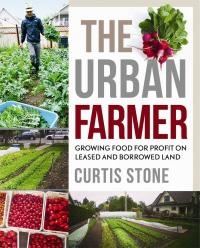
Curtis Stone, the author of “The Urban Farmer”, sums up the purpose of his book with a most succinct subtitle: “Growing Food for Profit on Leased and Borrowed Land.” This is a manual for a very specific but growing audience. While there are many books to provide inspiration for would-be urban farmers, I don’t know of any other that is so detailed in the nuts and bolts of turning this activity into a part- or full-time livelihood.
Gardening advice is mostly on crop rotation and timing, most profitable selections, and the preparation of the harvest for sale – all key points in running a business. Chapters cover market streams, labor, self-promotion, and finance options. The author is clear that there’s no point in doing this unless you eventually make a living at it. He also warns to start small, don’t overextend yourself, and be realistic about the demands on your time and finances.
Stone lives in Kelowna, British Columbia, a city of 117,000, but he is familiar with the needs and challenges of farming in both larger, denser cities and on what he calls peri-urban land: the larger, often 1-2 acre lots where the suburbs make the transition into the rural countryside. He gives the pros and cons of having all your crops at one site (often not possible in an urban setting), or the more likely model of having multiple plots.
How do you find these plots? He has several suggestions and provides a 10-point checklist to consider for each potential site. Before you begin reviewing the list, he does bend a bit from his typical, matter-of-fact tone by reminding the reader that you as a farmer are valuable. “Approach all negotiations [with landowners] from a place of abundance. You are the one in demand, because you are scarce. Land is abundant!”
Excerpted from the Spring 2016 Arboretum Bulletin.